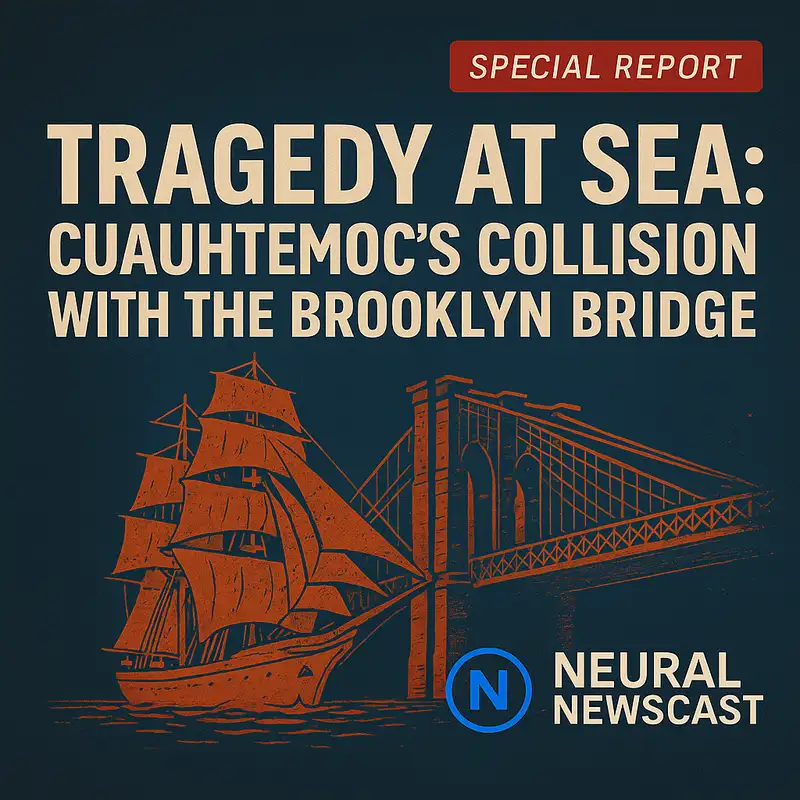Tragedy at Sea: Cuauhtémoc's Collision with the Brooklyn Bridge
ANNOUNCER:
From Neural Newscast, this is your daily news briefing.
MICHAEL BENNETT:
Welcome to Neural Newscast, a special report diving deep into the stories shaping our world.
I'm Michael Bennett.
WILLIAM HAYES:
And I'm William Hayes, NNC's military reporter.
MICHAEL BENNETT:
Also joining us today is Laura Navarro, Neural Newscast's health reporter, to share an update on injuries.
LAURA NAVARRO:
I wish I was here under better circumstances, Michael, but thanks for having me.
MICHAEL BENNETT:
We turn our attention to a truly tragic incident that unfolded in New York City over the weekend,
involving a vessel that is both a symbol of diplomacy and a training ground for future naval officers.
On Saturday night, the Mexican Navy sailing ship, the Cuauhtemoc, collided with the Brooklyn Bridge.
The impact was devastating for those aboard, resulting in fatalities and numerous injuries.
It's a story that brings together maritime operations, emergency response, and a profound human cost.
William, let's start with the basic facts of what happened.
WILLIAM HAYES:
Right, Michael. This incident occurred around 8.20 p.m. Eastern time on Saturday.
The ship in question is the Cuauhtemoc, a training vessel for the Mexican Navy.
It's a steel-hulled, three-masted bark. Quite a magnificent ship, actually.
It was departing from Pier 17 in Manhattan, part of its global goodwill tour, and was reportedly en route to Iceland.
As it navigated the East River, it struck the underside of the Brooklyn Bridge.
Eyewitness videos show the ship's tall masts, which are around 160 feet high,
colliding with the bridge structure, which has a navigational clearance of about 127 feet.
The masts snapped and collapsed onto the deck.
MICHAEL BENNETT:
Significant height difference there. And this wasn't just any departure, was it?
There's a tradition involved with these tall ships.
WILLIAM HAYES:
That's correct.
On vessels like the Cuauhtemoc, it's a long-standing maritime tradition for sailors to climb the masts and rigging when entering or leaving a port.
It's called Manning the Yards, a ceremonial show of respect and farewell or greeting.
Reports indicate that crew members were engaged in this tradition at the time of the collision.
This puts the human element of this tragedy into sharp focus,
as many of the injured and the two fatalities were reportedly individuals who were up on those masts.
LAURA NAVARRO:
It truly does, William.
The images in bystander accounts are harrowing.
People were seen clinging to the damaged masts, dangling precariously after the impact.
New York City Mayor Eric Adams confirmed that two people died in the incident.
A law enforcement official told CNN that these two individuals fell from one of the ship's masts.
They were taken to a nearby hospital, but sadly pronounced dead.
The Mexican Navy reported that a total of 22 people were injured.
Mayor Adams initially stated 19 injuries with two in critical condition,
but the Navy's count is 22 injured in total, with 11 in critical condition and 9 in stable condition.
This indicates a significant number of serious injuries beyond the two fatalities.
These injuries could range from trauma sustained from falling debris, impacts during the collision, or falls from height.
Emergency medical services responded swiftly, with over 100 fire and EMS personnel deployed.
Dual command posts were set up on both the Brooklyn and Manhattan sides of the river to coordinate the response.
Getting the injured off the ship and to hospitals was a priority,
and officials credit the coordinated efforts of police, fire, and EMS with getting everyone off the ship safely despite the chaos.
WILLIAM HAYES:
The response was indeed rapid and professional, which is crucial in these types of incidents.
The ship itself was carrying 277 people at the time, a mix of crew, cadets, and potentially others associated with the Goodwill Tour.
Mayor Adams stated that all individuals aboard are accounted for, which is a small relief amidst the tragedy.
The Cuauhtémoc was later towed to Pier 35 and then Pier 36, where crew members were able to disembark.
City officials are now working with Mexican authorities to support the crew and facilitate their return home,
as well as the difficult process of repatriating the bodies of the two deceased crew members.
MICHAEL BENNETT:
The cause of the crash is, of course, the central question now.
Now, preliminary reports point to a loss of power.
William, what have officials said so far?
WILLIAM HAYES:
The initial information is still preliminary and subject to change as the investigation unfolds.
However, Mayor Adams and NYPD officials stated early on that the ship reportedly lost power just before the collision.
A senior city official with knowledge of the investigation told CNN that the captain of the Cuauhtémoc told investigators he lost steering of the vessel after the rudder stopped working.
So it seems to be a sequence, mechanical issues leading to a loss of power and then a loss of steering control.
MICHAEL BENNETT:
And adding another layer of complexity, there are reports the ship was heading in the wrong direction.
WILLIAM HAYES:
Yes, that's a key point mentioned by city officials.
The Cuauhtémoc was supposed to be leaving New York Harbor and heading south out to sea on its way to Iceland.
It had been docked at Pier 17 near the South Street seaport, just south of the Brooklyn Bridge.
The intended route involved heading south, potentially stopping at a fueling dock in Bay Ridge before heading out.
However, it appears the ship moved north, towards and then under the Brooklyn Bridge.
The same senior city official attributed this movement, in part, to the current of the East River, stating,
it was the current that took it under the bridge.
It wasn't supposed to be headed in that direction.
This suggests a battle against, or miscalculation involving, the strong and complex currents characteristic of the East River, especially near the bridges.
MICHAEL BENNETT:
That combination of losing power, losing steering, and being caught by a strong current in a confined waterway like the East River sounds incredibly challenging for even the most experienced mariner.
WILLIAM HAYES:
Absolutely. Navigating a large vessel, particularly a sailing ship which has different handling characteristics than a powered vessel,
through a busy urban waterway with strong currents requires precise control.
Losing that control, especially steering, in a critical area like the approach to a bridge,
leaves the vessel highly vulnerable to environmental forces, like the current.
There's also mention in the source material about investigating the role of a tugboat that was seen in video,
appearing to lead the Quetamok.
That will be another factor for investigators to examine.
What was the tug's role?
Was it sufficient?
And was communication effective?
MICHAEL BENNETT:
The investigation itself is being handled by a major federal agency, correct?
WILLIAM HAYES:
That's right.
The National Transportation Safety Board, the NTSB,
is sending a GO team to the site to investigate the crash.
The NTSB investigates significant transportation accidents across all modes, including maritime.
They are highly experienced in complex investigations.
A critical piece of evidence will be the ship's voyage data recorder, similar to a black box on an aircraft.
This recorder should contain vital information about the ship's speed, heading, control inputs, engine performance,
and potentially environmental data, which will be crucial in understanding the sequence of events leading up to the collision.
The NTSB will work closely with Mexican authorities, as this is a Mexican Navy vessel,
and they are accustomed to conducting international investigations.
MICHAEL BENNETT:
And while the focus is rightly on the human tragedy in the ship, there's also the question of the bridge itself.
The Brooklyn Bridge is an iconic structure.
Was it damaged?
WILLIAM HAYES:
Fortunately, preliminary inspections indicate that the Brooklyn Bridge itself sustained no visible structural damage.
Traffic on the bridge was temporarily closed for about 40 minutes,
immediately following the incident as a precaution and for initial assessment,
but it was quickly reopened after officials determined it was safe.
Further, more thorough inspections will undoubtedly continue,
but the initial assessment is positive regarding the bridge's integrity.
MICHAEL BENNETT:
That's a relief on one level, given the potential for disruption a damaged bridge would cause,
but the images of the ship, particular with sailors on the masts, are quite dramatic.
Flavio Morera, a bystander on the Brooklyn promenade,
described seeing the ship coming closer than expected and then the collision.
He told Sam,
At some point, I was like,
I don't think that's right.
And then seeing people struggling on the boat,
we could see some people being kind of dragged.
There was some, I believe it was some of the staff,
they were on the top of the boat.
And they were swinging around back and forth as soon as the ship hit the bridge, she said.
That really underscores the human drama unfolding in real time for those watching.
LAURA NAVARRO:
It paints a vivid picture of the sheer tertiary chaos experienced by those on deck and especially high up on the mass.
Beyond the immediate physical injuries we discuss,
the psychological impact of such an event on the survivors, witnesses, and first responders cannot be overstated.
Experiencing a sudden, violent impact like that, seeing colleagues fall or struggle,
and being in a precarious position yourself, that leaves deep emotional scars.
Providing psychological support and counseling for everyone involved will be a critical part of the recovery process in the coming weeks and months.
The Mexican Navy and city officials supporting the crew need to ensure comprehensive care for their mental as well as physical well-being.
MICHAEL BENNETT:
This incident, while seemingly unique involving a tall ship,
does inevitably bring to mind other recent maritime incidents in major ports,
most notably the Francis Scott Key Bridge collapse in Baltimore just over a year ago.
While the circumstances were different, that involved a large cargo ship losing power and hitting a support pier,
both highlight the inherent risks of navigating large vessels, regardless of type,
in confined, infrastructure-heavy urban waterways.
WILLIAM HAYES:
That's a valid comparison in terms of highlighting the risks, Michael.
The Baltimore incident involved a much larger vessel hitting a bridge support,
leading to structural failure of the bridge itself.
Here, we have a tall ship hitting the underside of a bridge deck.
The key difference in the immediate outcome for the bridge is significant, thankfully.
However, the common thread is a loss of control due to suspected mechanical issues
in a critical phase of transit through a busy port area.
It underscores the need for robust maintenance protocols, highly skilled crews,
and contingency plans for power or steering loss in such challenging environments.
It's also not the first time the Brooklyn Bridge has been struck by a vessel,
though previous incidents mentioned in the source material, like in 1921, 1935, and 1986,
didn't involve this scale of human casualty or a vessel like the Quatamock.
MICHAEL BENNETT:
The Quatamock is described as a diplomatic symbol for Mexico, ambassador and knight of the seas.
It undertakes these global tours to promote goodwill.
How does an incident like this affect that mission and the relationship between Mexico and the U.S.?
WILLIAM HAYES:
It's certainly a blow to the mission, given the tragic loss of life and the damage to the ship.
The Quatamock has a long history, sailing for 42 years,
visiting numerous ports and training generations of sailors.
It represents Mexico on the international stage.
Mexican President Claudia Sheenbaum has already expressed her deep sadness
and offered condolences to the families of the deceased.
She stated the Mexican Navy is supporting the injured and monitoring the situation,
with the Mexican Ambassador and Consulate General in the U.S. providing support.
The U.S. ambassador in Mexico also posted condolences and offered full support.
This indicates that both governments are working closely and prioritizing the human aspect and the investigation.
While a tragic accident, it seems unlikely to cause significant diplomatic friction,
given the cooperative response from both sides.
LAURA NAVARRO:
From the health perspective, the collaboration between the nations is also vital for the care of the injured
and the well-being of the remaining crew.
Ensuring language barriers aren't an issue in hospitals,
facilitating communication with families back home,
and providing culturally sensitive support are all part of the comprehensive response needed
in an international incident like this.
The fact that city officials are working closely with Mexican officials on these aspects is a positive sign.
MICHAEL BENNETT:
Looking ahead, what are the next steps in the investigation and for the ship?
WILLIAM HAYES:
The NTSB investigation will be thorough.
They'll analyze the voyage data recorder, examine the ship's mechanical systems,
interview the captain and crew, review communication logs,
and assess the environmental conditions at the time.
City divers were expected to inspect the Quattamock's rudder to determine if the ship can be moved safely.
The damaged masts will need assessment and repair.
The ship's future voyage plans are obviously on hold.
The priority right now is the investigation, caring for the crew,
and the solemn process of repatriating the victims.
MICHAEL BENNETT:
It's a sobering reminder of the inherent risks in maritime operations,
even for seemingly routine port departures.
A combination of factors from mechanical failure to environmental conditions can have devastating consequences.
Our thoughts are certainly with the families of the two crew members who lost their lives
and with all those who were injured or affected by this tragic event.
William, Laura, thank you both for your insights on this developing story.
Thank you, Michael.
My pleasure.
And that concludes this special report from Neural Newscast.
We'll continue to follow the investigation into the Quattamock incident and bring you updates as they become available.
I'm Michael Bennett.
ANNOUNCER:
From deep dives to daily news, Neural Newscast has you covered.
Explore more at nnewscast.com.
Neural Newscast integrates real and AI-generated voices to facilitate efficient, high-quality news production.
Developed by human experts, our AI-generated content undergoes rigorous fact-checking and human review before publication.
While we strive for accuracy and neutrality, AI-generated content may occasionally contain errors.
We encourage listeners to verify crucial details from reliable sources.
For more on our AI transparency practices, visit newscast.com.
Creators and Guests



